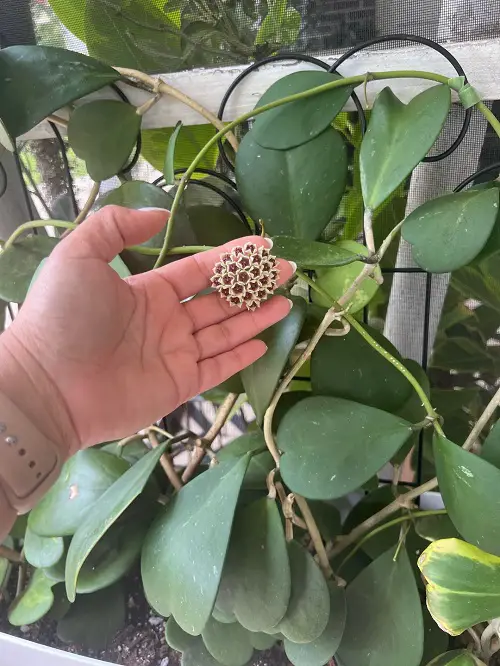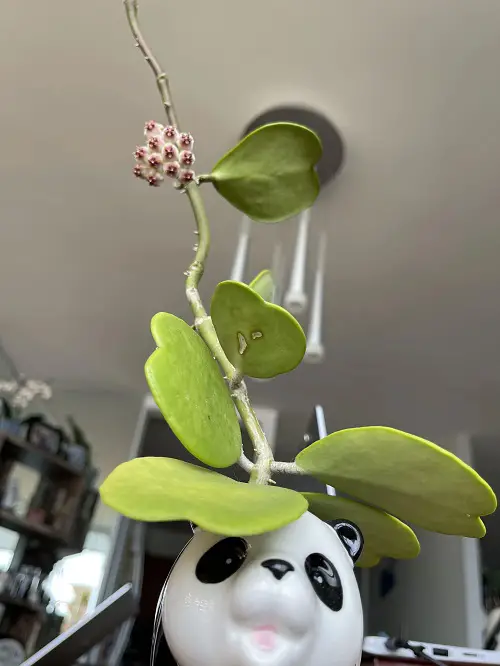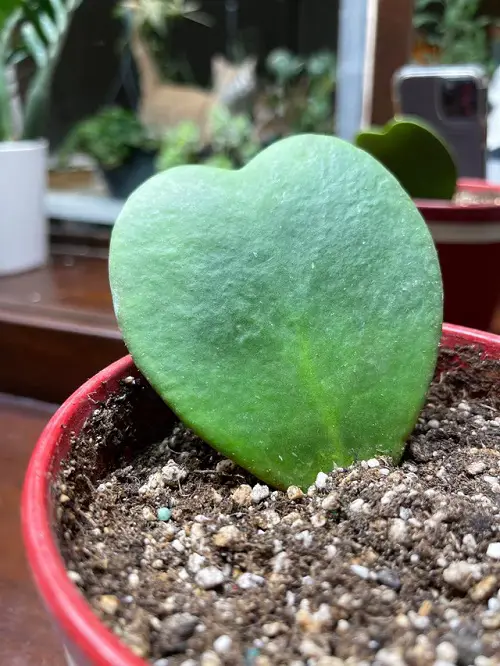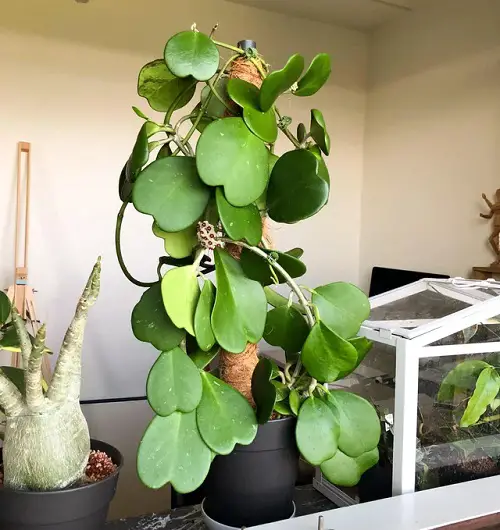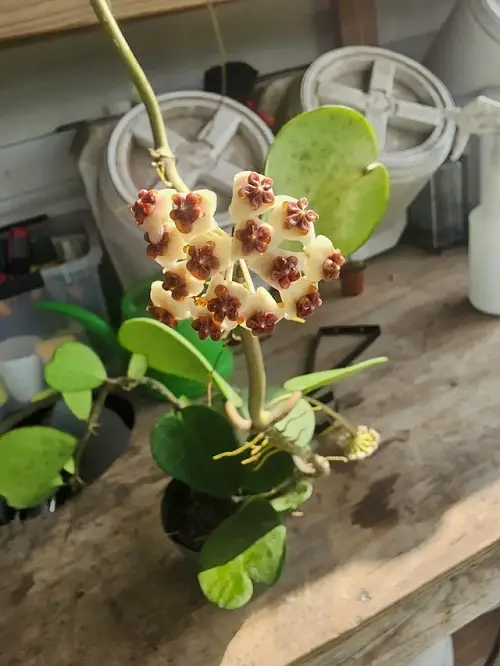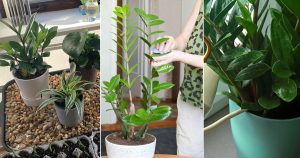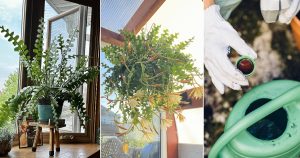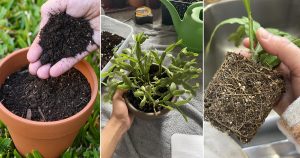Love that bunch of flowers in your Hoya plant? Then learn these simple ways to help Hoya Kerrii Hearts bloom!
Hoya Kerrii is a super popular, low-maintenance houseplant, loved for its adorable heart-shaped leaves. While it’s mostly grown for its leaves, this plant can actually bloom after it matures, which usually takes about 2-3 years. Curious about how to get it to bloom? Keep reading for simple tips on how to make that happen!
Hoya Kerrii Heart Plant Facts
| Common name | Hoya Kerrii Hearts |
| Scientific name | Hoya Kerrii |
| Plant type | Climbing Succulent |
| USDA Zones | 11-12 |
| Sunlight | Bright, Direct Sunlight |
| Watering | 1-2 weeks in spring and summer |
| Soil type | Well-draining, airy soil |
| Temperature | 65°F to 80°F |
| Propagation time | Spring and Summer |
| Flower | White, pale pink, or red star-shaped |
| Indoor/ Outdoor | Both |
Hoya Kerrii Hearts Information
One of the most loved types of Hoya is the Hoya Kerrii, or as many people like to call it, the Sweetheart Plant or Valentine Hoya. Why? Well, it’s all about those thick, heart-shaped leaves that grow on long, slender vines. When the plant is ready to bloom, it surprises you with cute star-shaped flowers that can be white, pale pink, or even red, and they smell amazing!
In its natural habitat, Hoya Kerrii can get pretty long, growing up to 13 feet in Southeast Asia’s tropical climate. But don’t worry, when it’s kept as a houseplant, it stays much more compact, usually around 2-3 feet long, depending on how much care it gets.
Interestingly, Hoya Kerrii has been used in traditional Southeast Asian medicine for treating burns and rashes. Its stems and sap contain compounds like triterpenoids and flavonoids, which are thought to be helpful.
Hoya Kerrii Heart Pot Size
Because Hoya Kerrii grows slowly, you’ll usually find it in smaller pots, around 4-6 inches wide when it’s young. It likes well-draining soil, so a cactus or succulent mix is ideal, and always make sure the pot has drainage holes. This way, you can avoid water buildup, which the plant definitely doesn’t like.
As for repotting, you only need to do it every 2-3 years. When you do, go for a pot that’s just a little bigger than the previous one, maybe 1-2 inches wider, to give the roots some space to grow without causing water issues.
Heart-Shaped Hoya Kerrii Propagation
Propagating your Hoya Kerrii is quite simple, and stem cuttings are the easiest way to go, especially in spring or early summer when the plant is actively growing. To start, all you need is a healthy stem from the mother plant. Make sure the stem is around 4 to 6 inches long, and once you’ve cut it, dip the end into rooting hormone to help encourage growth.
Before planting, let the cutting sit for 2-3 days to form a callus—this helps reduce the risk of rotting. After that, plant it in a well-draining mix, ideally something like a succulent or bark mix, and place it in bright, indirect light. And, keep the soil airy and only water when the top layer feels dry to the touch, ensuring your new plant stays happy and healthy.
How to Help Hoya Kerrii Hearts Bloom?
Hoya Kerrii leaves look like small hearts and its flowers look like stars. These flowers are normally creamy or pink and tend to appear in clusters. Blooming Hoya Kerrii hearts can be a pretty challenging task but following these simple ways will reward you with a flowering Hoya Kerrii.
1. Give it Bright and Indirect Light
Your Hoya Kerrii loves bright, indirect light, making it perfect for a sunny spot indoors. A south-facing window with filtered sunlight works great, but avoid placing it in direct sunlight as it could scorch the leaves. It can handle lower light, but don’t expect much growth or flowers in dim conditions.
2. Consistent Watering
This plant doesn’t need much water, especially in spring and summer. Water it every 1-2 weeks, letting the top inch of soil dry out between watering. As the seasons change, cut back on watering to once every 2-3 weeks in fall and winter.
Overwatering can lead to root rot, so be careful. Fluctuation in the watering schedule will stress the plant and adversely affect flowering.
3. Good Soil is a Must
Hoya Kerrii does best in well-draining soil. A mix of orchid bark, perlite, and succulent soil is perfect as it keeps moisture from sticking around the roots. You can even add coconut coir for extra moisture control without making the soil soggy.
4. Supply a Phosphorous-heavy Fertilizer
Feed your plant a balanced liquid fertilizer every 4-6 weeks in the growing season to provide the required nutrients. A fertilizer with a high phosphorus content will also help stimulate flowering.
5. Apply Stress
Introduce controlled stress by tying the plant, root-bound, because this will direct energy into reproduction from vegetative growth. Still, do not tie it too tight because overstress may lead to the plant turning dormant.
6. Maintain Constant Temperatures
The best temperature range to promote blossoming is between 65 and 80°F, and anything under 50°F can damage the plant. You should avoid drastic changes, as stability leads to the flowering and well-being of Hoya Kerrii Hearts.
7. Prune Regularly
Promptly removing yellowing leaves also stimulates new growth that is more likely to produce blooms. Pruning also allows better air circulation and might prevent pests.
8. Provide Support to your Hoya Kerrii Hearts
Let your plant climb! A trellis or other support structure gives it the room to grow and can encourage blooming.
9. Don’t Repot Too Often
Only repot your Hoya Kerrii when it’s absolutely necessary. Disturbing the roots can delay blooming, so leave it in its current pot unless it’s outgrown it.
10. Patience is Key
Hoya Kerri Hearts can take somewhere between 2 and 3 years to produce flowers. Try to be patient with this plant, and it will reward you at the right time with consistent care.
Have you had any success with getting your Hoya Kerrii Hearts bloom? Share your tips or stories in the comments—we’d love to hear how it’s going!

